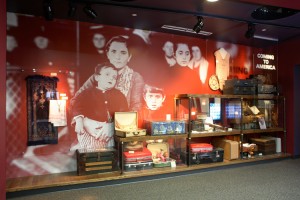Arab American National Museum
April 12, 2018
In appreciation of Arab American Heritage Month in April, World Book pays a visit to the Arab American National Museum (AANM) in Dearborn, Michigan. The AANM is the first and only museum in the United States devoted to Arab American history and culture. Arab Americans are Americans who have roots in the Arab world—that is, the areas where people speak the Arabic language and share other cultural traditions. The Arab world includes much of the Middle East, the region that spreads across southwestern Asia and northern Africa. Arab American accomplishments, as well as the traditions of the Arab world, have strongly influenced life and culture in the United States. Americans of Arab descent have made significant contributions to virtually every field and profession.

The Arab American National Museum in Dearborn, Michigan. Credit: Doug Coombe, Arab American National Museum
The Arab American National Museum, which opened in 2005, shares the experiences of Arab Americans through stories of immigration and assimilation and exhibits on Arab American art, culture, and history. Part of the AANM’s goal is to dispel misconceptions and promote cultural understanding between Arab Americans and their fellow citizens. The AANM’s location in Michigan reflects the state’s high percentage of Arab American citizens in the population—1.69 percent, the most of any state in the country. California, Illinois, Massachusetts, New Jersey, and New York also have large numbers of Arab American citizens. The AANM is affiliated with the Smithsonian Institution and is a founding member of the Immigration and Civil Rights Network of the International Coalition of Sites of Conscience, an organization dedicated to human rights around the world.

The Coming to America exhibit at the Arab American National Museum. Credit: Arab American National Museum
The AANM collections include art, artifacts, documents, personal papers, and photographs connected to the Arab American experience. Four themed permanent exhibits represent the central core of the museum: Coming to America, Living in America, Making an Impact, and Arab Civilization: Our Heritage. An AANM traveling exhibit, “What We Carried: Fragments & Memories From Iraq & Syria,” is currently touring other U.S. museums. The AANM also sponsors conferences, performance art, film festivals, craft classes, diversity training, and other events and programs. The museum’s Russell J. Ebeid Library and Resource Center keeps the single largest collection of Arab American material in the United States.
Like other immigrants, Arabs came to the United States seeking better opportunities. The first significant number of Arab immigrants arrived between 1880 and 1920. The numbers dropped sharply because of restrictive immigration laws passed after World War I (1914-1918). Those laws were changed in the 1960′s, and the Arab American population has increased rapidly since the 1970′s.


